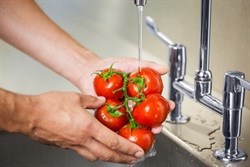
Subscribe & Follow
Advertise your job vacancies
Jobs
Consumers' responsibility to food safety
Consumers need to ensure the safe transport, handling and preparation of the food they buy, to extract its full nutritional value, avoid unnecessary health risks and complete the safe journey that responsible retailers have begun.

© WavebreakMediaMicro - Fotolia.com
The way groceries are transported, stored and consumed has an effect on the safety of the food you eat every day and this is often neglected.
Poor food handling practices during preparation and storage can cause food to become less nutritious or contaminated, posing a health risk. This is particularly true when preparing and storing foods for lunchboxes that are carried out of the home to work or school each day.
Lunchbox tips
During preparation:
- Wash your hands with warm, soapy water before preparing food
- Wash utensils and countertops with hot, soapy water before preparing food
- Ensure that your foods have not exceeded their expiry dates
- Wash fruit and vegetables, especially if they will be eaten raw
- Use separate equipment and utensils for fresh produce and for raw meat and poultry to avoid cross-contamination
- Ensure that food requiring cooking is cooked thoroughly
- Use clean packaging and bags to pack food
- Keep perishable food refrigerated until it is time to leave home with it
During the day:
- Perishable food must be kept cold while commuting via bicycle, car, bus, or on foot. Food should not be kept at room temperature for more than 2 hours (1 hour if temperature is above 32°C)
- Include a frozen gel pack or frozen juice box with perishable food in an insulated lunch bag or lunch box
- After arrival, perishable food should be kept cold. If possible, store perishable items in a refrigerator immediately upon arrival
- For food and drinks that need to be kept hot throughout the day, use an insulated container to keep foods at 60°C or above
- If your food needs to be reheated before being eaten, ensure the food is thoroughly heated to a temperature of 65°C or above
- Cook frozen convenience meals according to package instructions, including standing time if using a microwave
- Wash hands with warm, soapy water before eating food
- Discard all used food packaging and paper bags after eating your lunch. Do not reuse packaging because it could contaminate other food and cause foodborne illness
Leftover tips
Leftovers can make for a convenient lunch the day after cooking, but remember these additional tips when handling leftovers:
- Divide large amounts of leftovers into small, shallow containers for quick cooling in the refrigerator
- Remove stuffing from meats and poultry and refrigerate it in a separate container
- Don't eat cooked or perishable foods that have been kept in the refrigerator for too long (no more than 2 to 3 days)
- Never taste food that looks or smells strange to see if you can still use it. When in doubt, throw it out
Useful knowledge
- Keeping food cold slows bacterial growth and keeps food safe
- Harmful bacteria multiply rapidly in the 'Danger Zone' - at temperatures between 5-60°C






